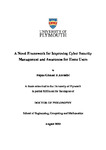A Novel Framework for Improving Cyber Security Management and Awareness for Home Users
| dc.contributor.supervisor | Clarke, Nathan | |
| dc.contributor.author | Alotaibi, Fayez Ghazai S | |
| dc.contributor.other | School of Engineering, Computing and Mathematics | en_US |
| dc.date.accessioned | 2020-08-27T06:55:41Z | |
| dc.date.issued | 2020 | |
| dc.date.issued | 2020 | |
| dc.identifier | 10511352 | en_US |
| dc.identifier.uri | http://hdl.handle.net/10026.1/16199 | |
| dc.description.abstract |
A wide and increasing range of different technologies, devices, platforms, applications and services are being used every day by home users. In parallel, home users are also experiencing a range of different online threats and attacks. Indeed, home users are increasingly being targeted as they lack the knowledge and awareness about potential threats and how to protect themselves. The increase in technologies and platforms also increases the burden upon a user to understand how to apply security across the differing technologies, operating systems and applications. This results in managing the security across their technology portfolio increasingly more troublesome and time-consuming. Thus, it is apparent that a more innovative, convenient and usable security management solution is vital. This thesis investigates current online awareness tools and reviews studies which try to enhance cybersecurity awareness and education among the home users. It is evident from the analysis that most of the studies which have made efforts in proposing “one-fits-all” solutions do not have the ability to provide the users with a tailored awareness content based on a number of criteria such as the current needs, prior knowledge, and security priorities for each user. The thesis proposes an approach for improving security management and awareness for home users by providing them with a customised security awareness. A design science research methodology has been used for understanding the current problem, creating and developing an artefact which can enhance security management and awareness for home users. A number of security controls and requirements were identified which need to be managed and monitored for different technologies and services. In addition, the research designed several preliminary interfaces which can show the main components and aspects in the proposed solution based on HCI principles. A participant-based study was undertaken to get feedback on the initial design requirements and interfaces. A survey of 434 digital device users was undertaken and reveal result that there is a positive correlation between the security concern, knowledge and management amongst home users towards different security aspects. Positive feedback and some valuable comments were received about the preliminary interface designs in terms of the usability and functionality aspects. This builds into a final design phase which proposes a novel architecture for enhancing security management and awareness for home users. The proposed framework is capable of creating and assigning different security policies for different digital devices. These assigned policies are monitored, checked and managed in order to review the user’s compliance with the assigned policies and provide bespoke security awareness. In addition. A mockup design was developed to simulate the proposed framework to show different interactions with different components and sections in order to visualise the main concepts and the functions which might be performed when it is deployed in a real environment. Ultimately, two separate focus group discussions, involving experts and end-users have been conducted in order to provide a comprehensive evaluation of the identified research problem, the feasibility and the effectiveness of the proposed approach. The overall feedback of the two discussions can be considered as positive, constructive and encouraging. The experts agreed that the identified research problem is very important and a real problem. In addition, the participants agreed that the proposed framework is feasible and effective in improving security management and awareness for home users. The outcomes have also shown a reasonable level of satisfaction from the participants towards different components and aspects of the proposed design. | en_US |
| dc.description.sponsorship | Saudi government | en_US |
| dc.language.iso | en | |
| dc.publisher | University of Plymouth | |
| dc.subject | Information Security Awareness | en_US |
| dc.subject | Information Security Management | en_US |
| dc.subject | Cyber Security | en_US |
| dc.subject.classification | PhD | en_US |
| dc.title | A Novel Framework for Improving Cyber Security Management and Awareness for Home Users | en_US |
| dc.type | Thesis | |
| plymouth.version | publishable | en_US |
| dc.identifier.doi | http://dx.doi.org/10.24382/951 | |
| dc.rights.embargodate | 2021-08-27T06:55:41Z | |
| dc.rights.embargoperiod | 12 months | en_US |
| dc.type.qualification | Doctorate | en_US |
| rioxxterms.version | NA |
Files in this item
This item appears in the following Collection(s)
-
01 Research Theses Main Collection
Research Theses Main


